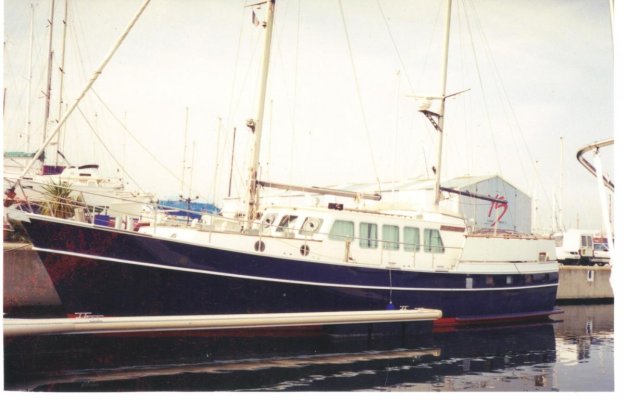We intend to cross both and beyond. This will be my last voyage and I want to explore every port, passage and country my ship will take me.
I don't have endless money but properly managed, we can sustain the fees associated with this kind of travel. We all want to stretch a dollar and fuel cost and berthing at certain ports i hope to find advice here.
All three are venerable builders with lots of experience and hulls under their belts. I have assisted clients in purchasing all three brands, and for the most part they are happily cruising aboard them, couples and families, for tens of thousands of miles.
I've been to the yards that build all of these vessel on multiple occasions, most recently just earlier this month, in Taiwan and China, they are capable and savvy, with some notable differences. I recently published an editorial about building in Asia here
https://stevedmarineconsulting.com/flooding-vs-siphoning/
Strictly speaking, while very seaworthy, Fleming does not make an ocean-crossing vessel, there was a time, if asked, Tony Fleming would say, 'if you want to cross oceans buy a Nordhavn'. I've written about passages I've made aboard Flemings, almost all all including open ocean passages, some of which you can read here.
https://stevedmarineconsulting.com/.../10/Norway-Passage-Nikita-YTG0718_FEA2-V1.pdf
https://stevedmarineconsulting.com/wp-content/uploads/2014/03/Alaska-YTG0717-V6.pdf
https://stevedmarineconsulting.com/wp-content/uploads/2014/03/Fleming-65.pdf
https://stevedmarineconsulting.com/wp-content/uploads/2014/03/FLEMING-58.pdf
Again, they are very capable sea boats, I've bene in conditions aboard Flemings I'd rather not repeat, they are solid and capable. Flemings have made ocean crossings, it's simply not their forte.
Nordhavn, on the other hand, does build purpose-made ocean-crossing vessels, I suspect more Nordhavns have circumnavigated and crossed the Atlantic and Pacific, and gone to the Arctic and Antarctic, than any other production power vessel. I've made many blue water passages aboard Nordhavns, including above the Arctic Circle, two of which are covered here...
https://stevedmarineconsulting.com/wp-content/uploads/2014/03/Greenland-The-Frozen-Coast.pdf
https://stevedmarineconsulting.com/...8/07/YTG0818_FEA4_PolarAdventure-Svalbard.pdf
While Kadey Krogens have crossed oceans, they are more akin to Fleming when it comes to cruising range and style, albeit it slower, most KKY owners make near or inshore passages. Most KKY's are single screw.
I haven't written about passages aboard Kadey Krogens only because I have been invited on any passages;-)
Perhaps the most important distinction is the hull types, (excepting their few planing models) KKY and Nordhavn are full displacement, while Fleming is semi-planing. This has two important effects.
One, your hull speed is limited by the vessel's length, so the KKY and Nordhavn cannot exceed this speed, depending on length typically between 6 and 9 knots. The Fleming can plane, partially, so its top speed could, depending on the model, be in the high teens, at which it will consume fuel at a high rate. The Fleming can, of course travel at displacement speed, efficiently, and that's how most operate. In all the miles I've traveled aboard Tony Fleming's Venture, and other Flemings of every model, other thna while on sea trials, virtually every mile was at displacement speed or slightly higher, perhaps 9-11 knots at most. Those few extra knots can make a big difference when traveling long distance.
Two, and this is an insidious difference that is often overlooked by buyers, displacement vessels can be loaded down with lots of gear and fuel, they are volume-rich, and they are designed to support it, and it has little effect on their performance or waterline. Planing vessels have less volume for storage, and added weight does affect performance, albeit less at displacement speeds, and the waterline and boot stripe begin to become one when heavily loaded, so if you are a gear hog, this should be taken into consideration.
Fleming participates in the ABYC/NMMA standards compliance program, which means the vessel is certified to meet a series of the most critical ABYC Standards.
Nordhavn does not participate in this program, however, in my experience they do go on the record to say they meet the most important standards, including electrical, fuel, propulsion, LP gas, batteries etc.
KKY also does not participate in the ABYC/NMMA compliance program. If you are having one built a discussion regarding ABYC compliance would be well worth having. I have found them willing to agree to meet most standards.
If you mentioned whether you were planning on new vs. used I missed it.
More on this subject here
https://issuu.com/spinsheetpublishingcompany/docs/nov_pt_2016/50
Finally, this two part article will give you a series of subjects to consider in the pre-evaluation process.
https://stevedmarineconsulting.com/a-boat-buyers-top-ten-guide-to-a-pre-offer-evaluation-part-i/
Happy hunting.


